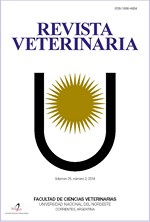Identificación de nematodos gastrointestinales en búfalos faenados en un frigorífico de Corrientes, Argentina
DOI:
https://doi.org/10.30972/vet.3114649Palabras clave:
Búfalos, nematodos gastrointestinales, larvas, necropsia parasitariaResumen
El objetivo del trabajo fue identificar y cuantificar los ejemplares adultos de nematodos gastrointestinales en los búfalos faenados en el frigorífico de Virasoro (Corrientes) mediante la necropsia parasitaria del tubo digestivo y, por intermedio de estudios coprológicos, correlacionarlos con el recuento de huevos por gramo de materia fecal y la proporción de géneros parasitarios de larvas de tercer estadio de los coprocultivos. Se realizaron en total 4 necropsias parasitarias que correspondieron a búfalos machos jóvenes, de los cuales el 50% presentó ejemplares adultos de Trichostrongylus sp y Haemonchus sp ubicados solamente en el abomaso. En los estudios coprológicos, el 75% de las muestras presentaron recuentos de huevos por gramo de materia fecal, de los cuales únicamente en dos casos se pudieron identificar larvas de tercer estadio de Haemonchus sp en los coprocultivos.
Descargas
Citas
Corticelli B, Lai M. 1963. Studies on the technique of culture of infective larvae of gastrointestinal strongyles of cattle. Acta Med Vet Napoli 9: 347-357.
Lukovich R. 1981. Identificación de las formas adultas de los nematodes gastrointestinales y pulmonares de los rumiantes en la República Argentina. Boletín Técnico del INTA. http://cnia.inta.gov.ar/helminto.
Niec R. 1968. Cultivo e identificación de larvas infectantes de nematodes gastrointestinales del bovino y ovino. Manual Técnico INTA 3: 1-37.
Roberts F, O’Sullivan P. 1949. Methods for egg count and larval cultures for strongyles infesting gastrointestinal tract of cattle. Aust J Agric Res 1: 99-102.
Steffan PE et al. 1994. Efectos en producción y control de nematodes gastrointestinales en bovinos. En: Nari, A.y Fiel, C. A. (Eds.), Enfermedades parasitarias de importancia económica en bovinos.. Edit.Hemisferio Sur, p. 131-153.
Wood IB et al. 1995. Guidelines for evaluating the efficacy of anthelmintics in ruminants (bovine and ovine). Vet Parasitology 10: 205-264.
Descargas
Publicado
Cómo citar
Número
Sección
Licencia
Derechos de autor 2020 S. I. Lobayan, J. H. Schapiro, C. A. Fiel, R. Ostriñuk, R. M. Genessini

Esta obra está bajo una licencia internacional Creative Commons Atribución-NoComercial 4.0.
Política de acceso abierto
Esta revista proporciona un acceso abierto inmediato a su contenido, basado en el principio de que ofrecer al público un acceso libre a las investigaciones ayuda a un mayor intercambio global de conocimiento. La publicación por parte de terceros será autorizada por Revista Veterinaria toda vez que se la reconozca debidamente y en forma explícita como lugar de publicación del original.
Esta obra está bajo una licencia de Creative Commons Reconocimiento-NoComercial 4.0 Internacional (CC BY-NC 4.0)










.jpg)
.jpg)



